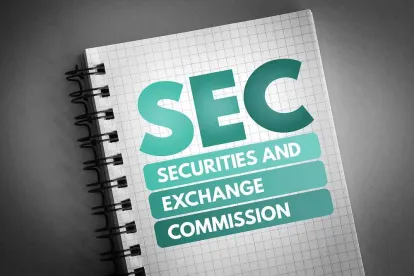OVERVIEW
On Wednesday, 26 October 2022, the U.S. Securities and Exchange Commission (the SEC), in a 3-2 vote, adopted final rules directing listing exchanges to require listed companies to establish, disclose, and enforce policies to recover, or “clawback”, excess incentive-based compensation paid to covered executive officers in the event of an accounting restatement due to material noncompliance with any financial reporting requirement under securities laws.
The final rules enact regulations initially proposed by the SEC in 2015 intended to implement Securities Exchange Act Rule 10D-1 (Rule 10D-1) and Section 10D of the Securities Exchange Act, which was added under the Dodd-Frank Wall Street Reform and Consumer Protection Act.1 The final rules adopt the proposed rules substantially as proposed, but with some noteworthy modifications, included to expand the scope of the restatements covered. Rule 10D-1 now requires listed companies to enforce clawback policies when material accounting errors require a restatement of past years’ financial statements (known as Big R restatements) or when corrections to nonmaterial errors in prior periods’ financial statements would result in a material misstatement during the current period’s comparative financial statements (known as little r restatements).2
POLICY REQUIREMENTS
New Rule 10D-1 requires securities exchanges to adopt listing standards that require most issuers to adopt a policy that provides for the recovery of incentive-based compensation received by covered current and former executive officers in excess of the amount such officers would have received if the compensation was based on restated financials, regardless of fault. Emerging growth companies, smaller reporting companies, foreign private issuers, and controlled companies are not exempt from the recovery and disclosure requirements. This marks a divergence from other prominent executive compensation rules, which either exempt such companies from compliance or require scaled-down compliance. The only exempted companies under Rule 10D-1 are issuers of security futures products, standardized options, unit investment trust securities, and certain registered investment company securities. Rule 10D-1 also prohibits companies from indemnifying current or former executive officers against losses from the recovery of erroneously paid incentive-based compensation (though Rule 10D-1 does not prohibit covered executive officers from purchasing third-party insurance to cover any such losses).
“Incentive-based compensation” is defined broadly by Rule 10D-1 as “any compensation that is granted, earned or vested based wholly or in part on the attainment of a financial reporting measure.” Rule 10D-1 specifies that stock price and total shareholder return are financial reporting measures for this purpose. “Incentive-based compensation” does not include compensation that is solely service based (e.g., time-based stock options) and, importantly, compensation that is earned solely upon satisfying one or more strategic measures (e.g., consummating a merger or divestiture), or operational measures (e.g., opening a specified number of stores, completion of a project, increase in market share). The definition of “executive officer” under the final rules tracks that of Exchange Act Rule 16a-1(f), and covers all “Section 16 officers,” and is not limited to a subset of officers, such as the named executive officers, or those officers who had a role in preparing the financial statements, and includes a company’s president, principal financial officer, principal accounting officer, vice president in charge of a principal business unit, division, or function, and any other officer or person who performs policy-making functions for the company. Foreign private issuers, which are not subject to Section 16 of the Exchange Act, will need to determine which of their executive officers are subject to the new clawback rules. The “recovery period” under the final rules is the three completed fiscal years prior to the date on which the company was required to prepare an accounting restatement, as measured from the earlier of (i) the date the board or committee, or an authorized officer concludes, or reasonably should have concluded, that the company is required to prepare the accounting restatement due to material noncompliance with any financial reporting requirement under securities laws or (ii) the date a court, regulator, or other legally authorized body directs the company to prepare an accounting restatement. Incentive-based compensation is deemed “received” when the pertinent financial reporting measure specified in the award is attained, even if grant or payment occurs during a subsequent period. For example, a performance stock unit grant that performance vests in 2023, but requires service through 2025, would be deemed “received” in 2023.
DISCLOSURE REQUIREMENTS
Rule 10D-1 also requires listed companies to disclose additional information related to their clawback policies on their periodic filings. The final rules amend Regulation S-K, Form 10-K, and Forms 20-F and 40-F to be consistent with Rule 10D-1. Under Amended Item 601(b) of Regulation S-K, every listed company is required to file its clawback policy as an exhibit to its annual report. It remains to be seen whether companies will adopt and publicly file a Dodd-Frank clawback policy for covered executive officers and maintain a separate, discretionary, and broader internal clawback policy (for example, covering employee misconduct generally and applying to a larger group of employees). Additional disclosure is required under Item 402(w) of Regulation S-K if, during or after the listed company’s most recently completed fiscal year, the company was required to prepare an accounting restatement that necessitated the recovery of erroneously awarded incentive based compensation or if there was an outstanding balance for the amount recoverable under its clawback policy. Item 402(w) of Regulation S-K requires issuers to disclose the date and amount of the erroneously awarded compensation, any estimates that were used in calculating that amount, and the amount of any erroneously awarded compensation that remains outstanding, among other information. Item 402(w) disclosures must be included on an issuer’s Form 10-K and/or proxy statement. The SEC has also added a check box on Forms 10-K, 20-F, and 40-F on which companies will indicate whether the company’s financial statements included in the filing contain a correction to previously filed financial statements, and whether any of those corrections triggered a recovery analysis under the company’s clawback policy.
LIMITED EXCEPTIONS
Rule 10D-1 provides for very limited exceptions to enforcing a clawback policy in the event of impracticability. The impartibility exception is only available where: (i) the direct expense paid to a third party to assist in enforcing the clawback policy would exceed the recoverable amounts and the company has made a reasonable attempt to enforce the clawback policy and provided documentation of its attempts to that company’s stock exchange; (ii) enforcing the clawback policy would violate home country laws that were effective prior to the date the final rules are published in the Federal Register, and the company provides an opinion of counsel to that effect to that company’s stock exchange; or (iii) enforcement would likely cause an otherwise tax-qualified retirement plan, under which benefits are broadly available to employees of the company, to fail to meet the requirements of the Internal Revenue Code.
IMPLEMENTATION TIMELINE
The timeline for companies to comply with the standards will depend on the implementation timeline of the particular securities exchange on which their securities are listed. The SEC has provided several transition and compliance deadlines. The new and amended rules take effect 60 days after they are published in the Federal Register. Each securities exchange is required to propose relevant listing standards within 90 days after the rules are published in the Federal Register, and the proposed listing standards must be finalized and become effective within one year after the rules become effective. Listed companies must adopt a clawback policy within 60 days after the listing standards of their exchange become effective and begin to comply with the required disclosures under the new listing standards and the amended rules for annual reports and proxy statements. We expect that final exchange rules will not be effective until mid-2023 at the earliest.
CONCLUSION
Compliance with the final rules and updated listing standards will involve a considerable amount of time, expense, and forethought. Companies should familiarize themselves and be prepared to comply with the policy requirements under the final rules as the baseline for the requirements the exchanges will likely adopt. Companies should also evaluate their current compensation arrangements to determine if any amendments are needed to comply with the rules. The final rules may influence how a company designs its incentive compensation plans. Companies may want to consider whether changes are needed to their plans to adjust performance metrics or otherwise in light of the final rules (including adding holdback and/or deferral provisions to cash incentive compensation arrangements and post-vest holding and/or no-transfer periods to equity award incentive compensation arrangements).
FOOTNOTES
1 See Pub. L. No. 111-203, 124 Stat. 1900 (2010).
2 See Listing Standards for Recovery of Erroneously Awarded Compensation, Exchange Act Release No. 34-96159 (Oct. 26, 2022) https://www.sec.gov/rules/final/2022/33-11126.pdf.
Erin L. Fogarty also contributed to this article.






 />i
/>i

